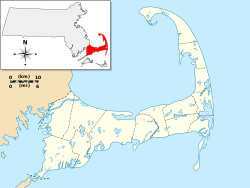Samuel Smith Tavern Site | |
 Smith Tavern excavation, c. 1970 | |
| Nearest city | Wellfleet, Massachusetts |
|---|---|
| Coordinates | 41°55′12″N70°03′26″W / 41.919906°N 70.057118°W |
| Built | 1690 |
| NRHP reference No. | 77000108 [1] |
| Added to NRHP | November 11, 1977 |
The Samuel Smith Tavern Site is a historic archeological site in Wellfleet, Massachusetts, United States. It encompasses the remains of a late 17th-century tavern operated by Samuel Smith, owner of Great Island, which shelters Wellfleet Harbor. The tavern site is located within the Cape Cod National Seashore, and is accessible via the Great Island Trail. [2] [3] The site was excavated in 1969–70, recovering thousands of artifacts, including clay pipes, drinking artifacts, a harpoon, and a chopping block fashioned from whale vertebrae. [4]
The tavern site was listed on the National Register of Historic Places in 1977. [1]



